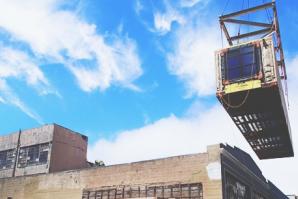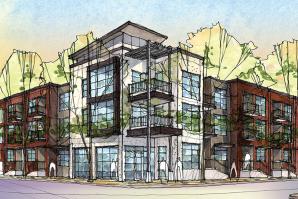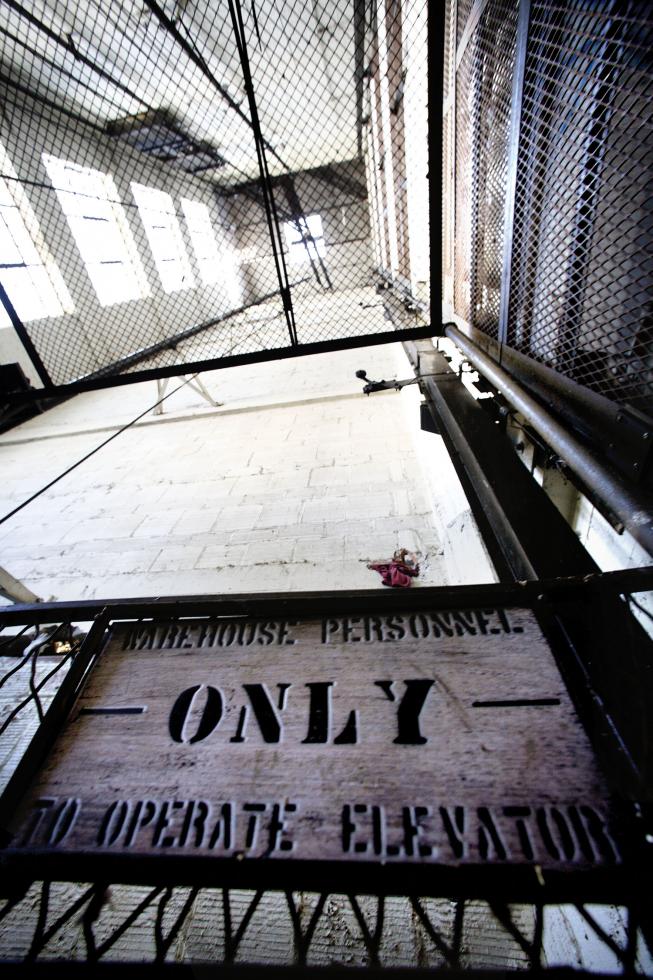On an early September morning, federal, city and redevelopment officials, among others, gathered at the corner of 10th and R streets to celebrate the beginning of street improvements.
In another part of Sacramento, building sidewalks and filling potholes might generate little fanfare. But on R Street the work is expected to spark development in a corridor where urban renewal has taken decades to flourish.
“This is the R Street rebirth,” Mayor Kevin Johnson said at the event.
The $6.1 million streetscape improvement from 10th to 13th streets is expected to reinvigorate economic investment in Sacramento’s original industrial district, which is 27 blocks long, two blocks wide and home to the West’s oldest railroad.
The project is expected to create 170 construction jobs and is one piece of a complex puzzle aimed at revitalizing an area that started making progress more than three decades ago. It is the initial phase of a four-part project that will beautify the blocks along R Street from 10th to 18th. In recent years, several projects were built along the R Street Corridor, which fueled momentum for others.
But the recession halted many plans.
The R Street Corridor is a special planning district encompassing 54 blocks within the central city that stretches from 2nd to 29th streets and from the southern side of Q Street to the northern edge of S Street.
In the 1980s the community began developing a vision for the street. In the end, two distinct visions emerged: Developers wanted to replace turn-of-the-century low-rise warehouses with high-rise offices, and residents favored a mixed-use, transit-oriented neighborhood that preserves the district’s industrial history and adds housing.
The latter idea, a 20-year plan the City Council adopted in 1996, makes the R Street Corridor a buffer, transitioning it from downtown high-rises to the surrounding residential neighborhoods.
There are some bright spots along the corridor, but overall “not as much has happened as people envisioned,” says Todd Leon, R Street development manager for Capitol Area Development Authority, a redevelopment agency and joint powers authority between the city and the state whose jurisdiction includes the heart of R Street, from 9th to 19th.
There have been many delays in turning the R Street Corridor into a thriving, vibrant district. Leon cites public infrastructure such as a lack of sidewalks and decaying utility pipes; soil and groundwater contamination leftover from turn-of-the-century industrial practices; and land values.
The R Street Corridor is a patchwork of mostly private property owners. Many owners of low-rise office buildings, for example, are not currently interested in turning them into housing or retail-housing hybrids, Leon says. If they want to sell, he says, typically they want an amount of money that would prohibit any buyer from building in today’s economy.
Laid out between 1849 and 1850, R Street became the site of the state’s first rail line when it was completed six years later. Easy access to transportation attracted industry, including a winery and a stonemason. Postwar freeway construction that favored truck transportation and a 1950s redevelopment model that discouraged downtown living pushed industry and residents into the suburbs, says Sacramento historian William Burg.
“Central city has always been a mixed-use transit-oriented neighborhood,” he says. “We had buildings that had retail on the ground floor and residential above since the Gold Rush. … We’re trying to get back to that.”
The first wave of redevelopment began in the 1970s and included the Fox and Goose pub and businesses in the adjoining building in the 1000 block of R Street. Today the corridor includes a mix of low-rise office buildings, surface parking lots, vacant land, housing, retail, industrial buildings and warehouses.
Only a handful of buildings are vacant; others are underused. Railroad tracks and light-rail run down some blocks of R Street, and the street itself is pockmarked with gravel, broken glass and weeds. New projects such as SoCap Lofts in the 600 block and the 1400 block’s housing and retail are like oases.
There have been more than a dozen projects along the R Street Corridor since 1999, according to CADA, including New Faze Development’s Alchemy at R Street, a mixed-use housing-retail project at 26th and R streets, and construction of Tuli Bistro and four condos in the Henley Building on S Street at 21st.
These projects and others like them are important because they give a glimpse of the corridor’s potential, Leon says. But the projects have been mostly small-scale and spread throughout.
“It’s not all been in one critical mass area,” Leon says. “That’s what we’ve struggled with.”
What Leon and others are hoping for is a housing project with at least 50 units. “I think you’ll see the snowballs start to roll,” he says.
One project can spur other development because it creates excitement, which attracts investors, says Bill Heartman, president of Regis Homes of Sacramento LLC, whose affiliates are involved in several R Street Corridor projects. “If you get one project that moves forward,” he says, “if it’s a sizable project, then it can have a dramatic impact on how the rest of the corridor moves forward.”
One expected game changer is the Capitol Lofts project at 11th and R streets. CADA owns a six-story warehouse that once housed Model T Fords, an adjacent vacant warehouse and two accompanying vacant lots. It’s a joint project between CADA and Capitol Lofts-Sacramento LLC, a partnership of Emeryville-based Holliday Development and Sares-Regis Group of Northern California LP.
The $45 million project would rehab existing structures and build 145 energy-efficient apartments with 8,000-square-feet of ground-floor retail. A parking garage and apartments would be built in the empty lot next to the CADA warehouse. Other elements are still in flux, says Rick Holliday, chief executive of Holliday Development, the project’s managing partner.
CADA’s redevelopment plan designated the site as housing in 1977. Official plans have been in progress for more than a decade, frustrating residents and business and property owners. Construction is expected to begin next fall, says Kevin Brown of Holliday Development.
The project has been saddled with delays, including cleaning up lead contamination, skyrocketing construction costs and the recession. But Holliday says he is confident the project is going forward. He attributes momentum in part to applying for Federal Housing Administration mortgage insurance he expects to be awarded and securing $4.9 million in Proposition 1C funds.
In the 2500 block of R Street, Pacific Housing Inc., ZETA Communities of San Francisco and Stockton-based Sunverge Energy teamed up to build an $11 million affordable housing project — 34 single-family homes expected to be available in the spring.
Developer Paul Petrovich’s R Street Market, which was built in 2005, has become a cornerstone of redeveloping the R Street Corridor, sparking a flurry of nearby development activity. Not all of it panned out, though.
The developer invested $70 million in a multipart infill project. He built a 52,000-square-foot Safeway, 16,000 square feet of retail and 11 lofts above the shops. He built additional retail at the corner of 18th and S streets and rehabbed a building across the street, which also houses retail. And in 2008, he transformed a warehouse and parking lot into 28 upscale lofts known as Whiskey Hill on the 2100 block of S Street. The project also included replacing an auto repair building next door with a Rite Aid.
Sacramento restaurateur Randy Paragary bought into the R Street vision when he purchased the eastern half of the once-derelict 1400 block in 2004. Paragary gutted and remodeled the building, a warehouse once used for the former bakery next door. The building houses Paragary’s Cafe Bernardo and adjoining R15 Bar, a nightclub and a hair salon, which along with the newly redeveloped western part of the block has breathed life into a once-desolate area.
In 2008, D&S Development Inc. bought the west end of the 1400 block, a city landmark that was the Perfection Bread Co. The firm’s vision was a “high-energy,” “unpretentious vibe” of housing and about 12,000-square-feet of retail, developer Bay Miry says. D&S converted the 1913 brick building into 13 lofts and five locally owned businesses. “Seeing what Randy (Paragary) did and what Paul (Petrovich) did, helped make it easier for us to see the potential was here,” Miry says, adding that without a grocery store nearby, lofts would have been a tough sell. “They were kind of the catalyst for us.”
On the west end of the R Street Corridor, CalPERS and Regis Homes of Northern California Inc. have made progress developing portions of a five-block stretch of R Street from 2nd to 7th streets.
In 2005, the state’s pension fund completed a 560,000-square-foot headquarters expansion that spans two full blocks from 3rd to 5th and Q to R streets. In some sections of the R Street Corridor, building offices also requires building a certain amount of housing. CalPERS signed an agreement with the city in 2001 to build 180,000-square-feet of housing along the corridor as long as those investments are profitable, says Diana Proctor, project manager of Cal-PERS’ headquarters expansion project.
CalPERS established an investment entity with Regis Homes of Northern California, which bought several parcels on R Street from 2nd to 7th in order to fulfill the pension fund’s housing obligation. So far, SoCap Lofts, 36 homes on the 600 block of R Street, which sold out in 2009, has been built. The partnership was shepherding two other housing developments on R Street through the city’s planning process, but both were put on hold until the economy recovers.
Another potential game changer is the Crystal Ice plant, which occupies two blocks of R Street between 16th and 18th. Mark Friedman, president of Fulcrum Property, bought the vacant graffiti-marked ice factory and cold storage warehouse complex in 2005. He envisioned 30,000-square-feet of retail, 100 lofts and converting the loading dock into a restaurant patio. He dubbed the few surrounding blocks “Ice Blocks,” hoping to spur nearby development. An empty Orchard Supply warehouse and a vacant lot sit across from the plant on the north side of R Street. A failing housing market forced Friedman to suspend plans in 2006 until the economy improves.
Improving public infrastructure could spark development along the corridor, experts say. Along R Street between 10th and 13th, the city is building sidewalks, preserving the railroad tracks and adding benches — changes business owners in “The Building” in the 1000 block of R Street say they hope make the area a destination. The second phase, in design now, will transform the Crystal Ice blocks into a pedestrian-friendly plaza that would close to traffic for events such as art shows and farmers markets.
Despite the slow pace, Leon and others say they’re optimistic. He expects projects to get built when the economy recovers, especially on CADA’s portion.
“I think people realize the potential is there. They’re just waiting for other people to get it going first (to) see how successful it will be,” he says. If the 1400 block is any indication, “there is no question the R Street Corridor has a bright future.”
Recommended For You

Putting the Fab in Pre-Fab
Modular construction cuts construction and energy costs
The final stages of construction at a trend-setting apartment project in San Francisco’s SoMa neighborhood, known by its address at 38 Harriett St., largely resembled a life-sized game of Tetris.

The Plight of CADA
Where goes the neighborhood?
Three years ago, Gov. Jerry Brown pulled the plug on local government redevelopment agencies and the estimated $5 billion a year they spend rebuilding inner cities to combat urban blight.



